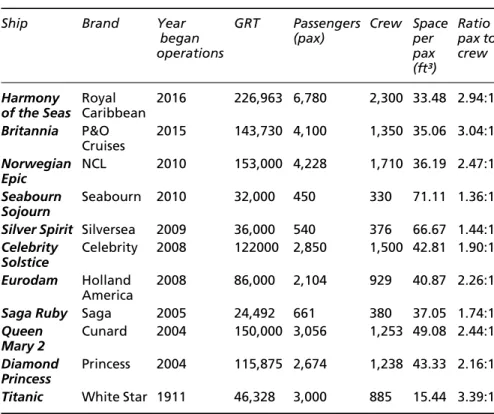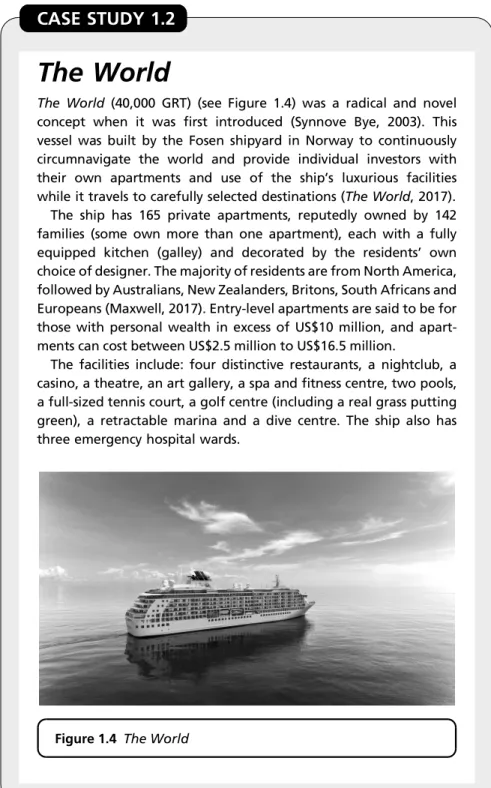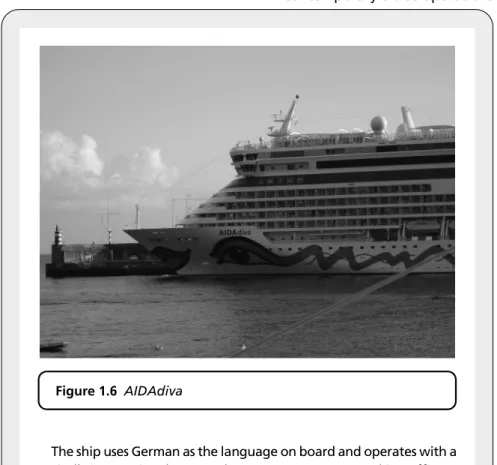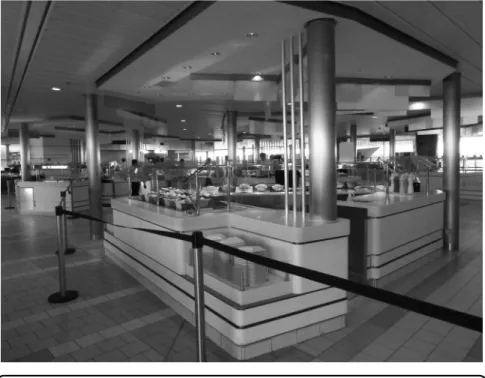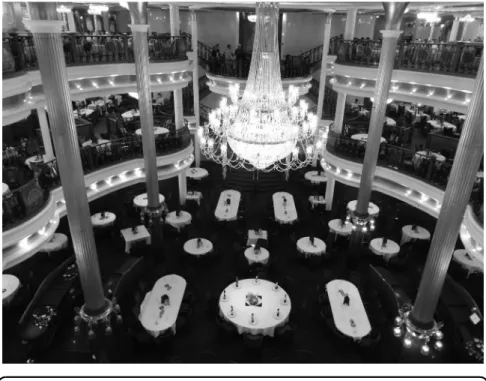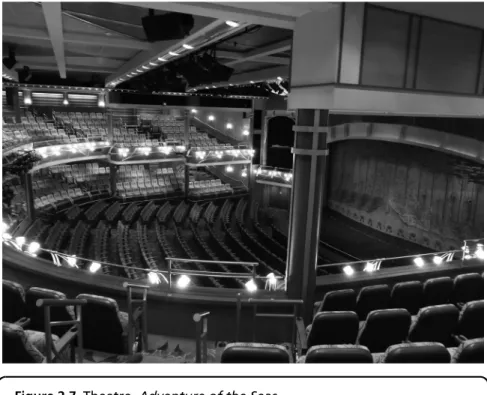These elements are discussed in the early part of this chapter and a timeline is provided which helps to develop a useful interpretation of the cruise industry. According to the Cruise Lines International Association (CLIA)—the cruise industry's trade organization—25.8 million people were expected to take a cruise in 2017 (CLIA, 2016).
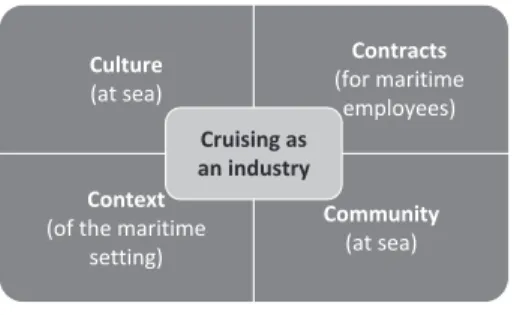
CASE STUDY 1.1
The 'flag' or country of registration is important because it refers to the legal status of the ship (see Chapter 3 for more information). While the ship has catered for the UK market for many years, it is now scheduled to be deployed in South America.
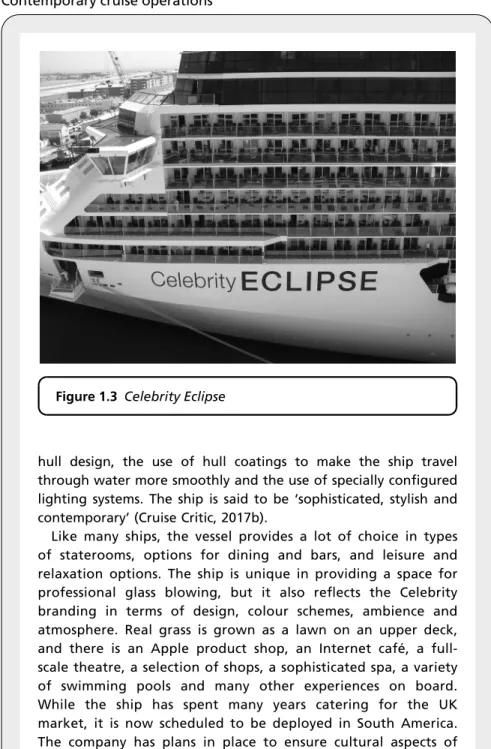
CASE STUDY 1.2
The ship is 15 years old, but due to the business model adopted, it is unlikely to age as a typical mass market ship could (Maxwell, 2017). It is said that an average of 150-200 guests are likely to be on board at any one time.
CASE STUDY 1.3
The ship is registered in Southampton, which means that weddings cannot take place at sea. The brand is proud of the tradition of P&O Cruises and presents the image that the ship provides choice, quality and value.
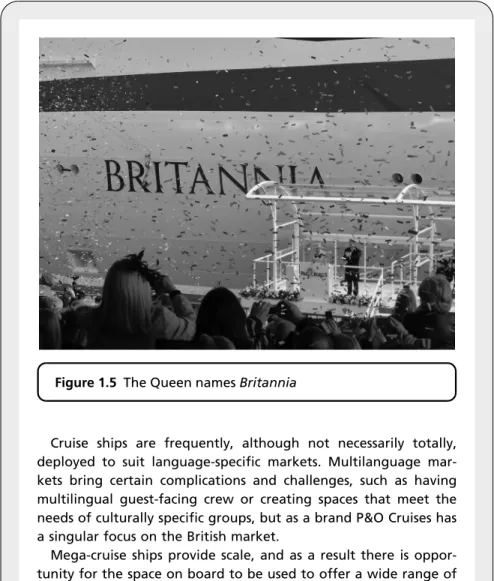
CASE STUDY 1.4
The ship makes use of themes including 'Strictly Come Dancing' and 'Food Heroes' with celebrity chefs to tap into currently popular social connections (or thezeitgeist) (Ireland, 2017). The ship uses German as the language on board and operates with a typical international crew and German or German-speaking officers.
CASE STUDY 1.5
Retrieved September 2017, from http://www.carnivalcorp.com/phoenix.zhtml?c=200767&p=irol-prlanding Cartwright, R., & Baird, C. The Development and Growth of the Cruise. Cruise observers can classify ships in a variety of ways - the number of passengers the ship holds; the quality of food, drink and accommodation; or an overall measurement of the cruise experience.
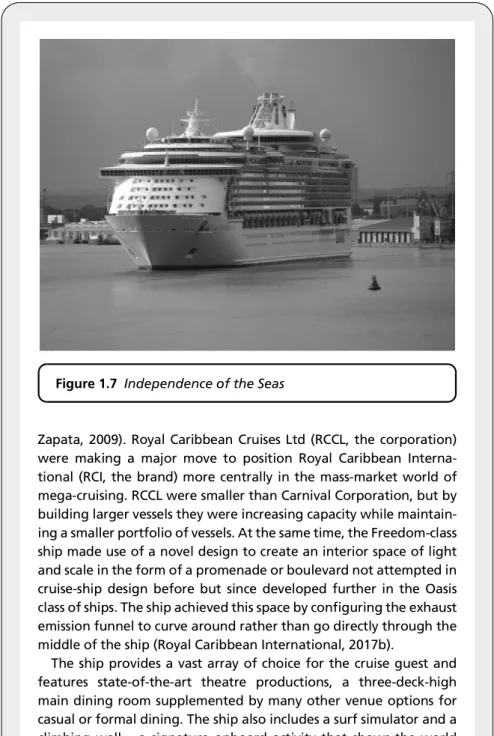
CASE STUDY 2.1
Cunard's brand pillars are based on heritage and tradition, grandeur and elegance, being 'British' or more precisely 'properly British', the 'Cunarder' community and built around legendary voyages. CRUISE', the service credo of P&O Cruises; and 'Elev8ʹ, a brand burnisher that aims to increase customer service by considering improvements in areas such as people, product and process. In this chapter, the cruise industry is placed in the context of the wider shipping industry.
Retrieved April 2011 from http://www.imo.org/about/conventions/. list of conventions/pages/international-convention-for-the-prevention-of-pollution-from-ships-%28marpol%29.aspx. imo.org/da/OurWork/Security/Guide_to_Maritime_Security/Documents/IMO%. www.imo.org/en/OurWork/Environment/SpecialAreasUnderMARPOL/Pages/. 2017c). Surviving disaster – Titanic and SOLAS. They are affected by many factors, including: the Sun's rays, the Earth's axis of rotation, which is tilted 23.5 degrees from perpendicular, thus creating seasonal variations (ie the four seasons), the land masses and oceans, currents, and the moon's gravity. pull (creates tidal variations). CLIA (2005) describes three specific parts of the Caribbean – the Eastern Caribbean and Bahamas, the Western Caribbean and the Southern Caribbean, and selected destinations from these areas are described in this section.
Palma is a Spanish city and the capital of the popular holiday island of Mallorca in the western Mediterranean. Rhodes, the 'Isle of Roses', is an attractive Greek island that embodies a place where ancient history combines with a modern beach holiday. The main island of Grand Terre, with the capital Noumea, is one of the largest in the Pacific Ocean.
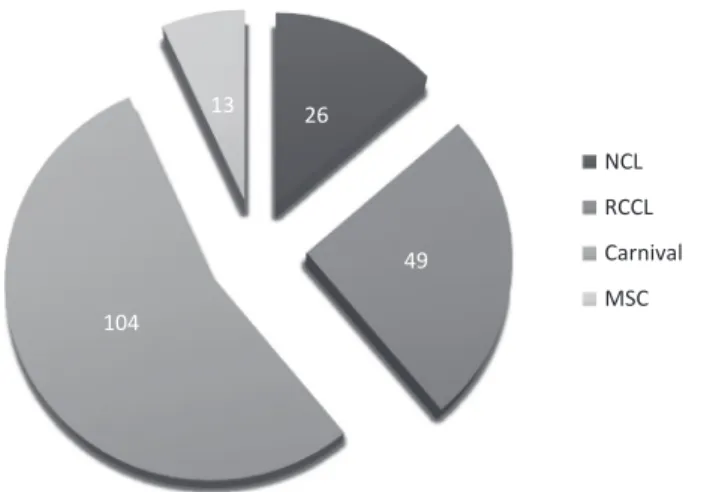
CASE STUDY 4.1
CASE STUDY 4.2
Also, cruise lines are beginning to increase the number of new ships using liquefied natural gas (LNG), which is said to produce 30% less carbon dioxide than normal marine oil or other fuels (World Cruise Industry Review, 2017). The notion of a shack or private beach may be an attractive idea to passengers because of the implied romance or because the idea may mean to some a prestigious and unique benefit. The visit to the cay is often planned to include a morning arrival and a late afternoon departure.
This optimizes the use of the cay and allows the company to build in additional services such as barbecues, water sports and organized games and activities. However, some observers are critical of this approach (Staletovich, 2016), noting that issues related to the environment and the amount of waste tourists produce, both on the ship and when visiting these fragile islands, are important and need to be further investigated. . In addition, points are raised about the ethical position of cruise lines in relation to the playgrounds of the Caribbean and the Bahamas.
Cruise companies generate large amounts of revenue from their islands by selling products and services, but, it is argued, the direct contribution to the trade of the local population in the Caribbean is being eroded (Robertson, 2004).
CASE STUDY 4.3
The port of Barbados is located south of the capital Bridgetown (see Figure 4.8). This reworked version of the tourism system suggests that the ship plays a central role in the relationship between the generating region and the. An analysis and comparison of the above will provide interesting lessons regarding the use of the Internet as a marketing tool for the cruise industry.
Plog believed that most of the population could be found in the central area. In terms of the mobility of people, goods and capital (Shaw & Williams, 2004), cruise companies may face the prospect of dealing with border controls. This routine varies depending on the regulations that apply and the nationality of the vessel under registration.
The choice passengers face is whether to be independent upon arrival in port or leave the subsequent organization and implementation of the shore experience to the cruise line.
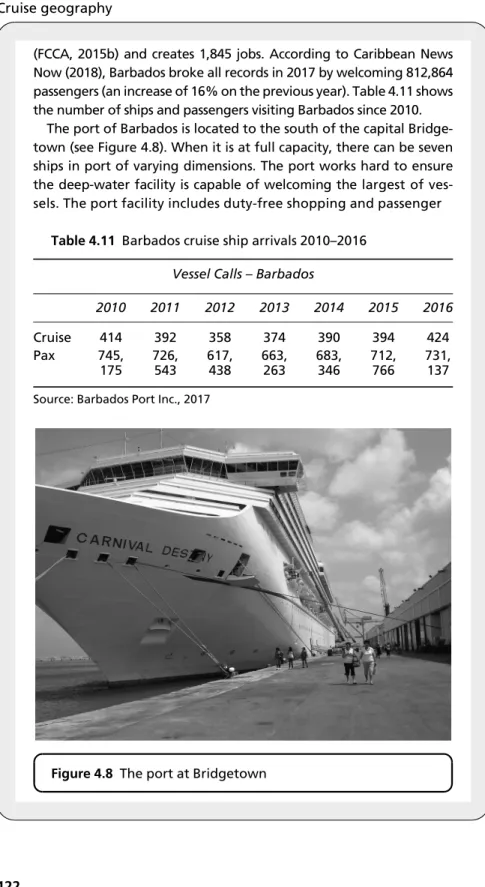
CASE STUDY 5.1
The hotel department is the focal point of this book and typically comprises about 80-85% of the staff. The organizational chart in Figure 6.1 is an example of a management structure for a large cruise ship. The master of the ship is responsible for the ship and also supervises the navigation and the deck department.
The chief officer or first mate (first officer) is responsible for the deck department on a day-to-day basis. One of the senior officers in this department will also serve as security officer. Crew positions include Chief Petty Officer (Chief Petty Officer) and Petty Officers (Chief Petty Officer) who supervise the deck crew under the direction of the Officers of the Deck; a deck carpenter who accompanies the mooring and departure; the quartermaster or helmsman, who is the senior seaman responsible for steering; junior seamen, seamen 2nd class and seamen 1st class - the latter two sharing watch and steering duties with officers of the deck; a bosun (boatman) who is a deckhand.
Given the size of the onboard community, it's not surprising that a cruise ship requires a medical team.
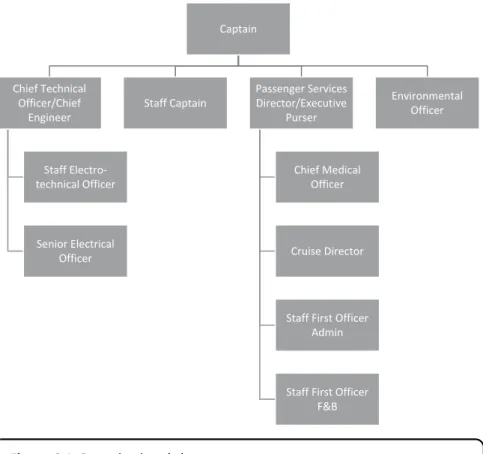
CASE STUDY 6.1
Juanita has been all over the world while working with Princess Cruises and recently went to Italy for the first time.
CASE STUDY 6.2
However, ships are also subject to audits and inspections that are in the public domain and can affect reputation. These examples highlight the demands of working in a hotel department and highlight the differences in jobs and responsibilities between a junior assistant cashier and a front-line cashier. In the worst-case scenario, the crew member may be sent ashore for further treatment and possibly repatriated.
It is in the cruise line's interest to provide the best accommodation possible to ensure that the crew is also happy, as was the case with the dining arrangements, with this part of their lives on board. Managers in the hotel department must have an appropriate bachelor's or postgraduate higher education qualification, which may be focused on business, hospitality or tourism. The University of Plymouth in the UK offers a three-year bachelor's degree (or four years with optional internship) - BSc (Hons) Cruise Management, which can assist those seeking a hotel management position on board a cruise ship. be prepared and qualified for this type of work (University of Plymouth, 2005).
It is not in the best interests of a cruise company to be faced with serious HR retention problems as it is expensive from a selection, recruitment and training point of view, potentially disruptive to other crew members and can impact have on service quality.
CASE STUDY 6.3
The benefits she gained in training include: familiarity with processes; understanding of the orchard language; orientation – she can understand the complex geography on board and adapt to it more easily; and raft handling (she had experience of handling a £50,000 raft when she spent time in the crew office during her training). Furthermore, she notes that there are times when dealing with difficult clients can be unpleasant. But there are also times when she can sit on the deck with a cocktail and it can seem like the best job in the world.
Working for months in a highly charged 'hot house' environment - an environment dominated by the dynamic sense of change, travel and convenient socializing - adds flavor to the employees' professional and social lives. New managers set the pace and style of the work environment, and it is not unusual for managers to cast a shadow over their teams because of a leadership style that may differ from that of their predecessors (Gibson, 2008). Yarnal and Kerstetter (2005) develop this further, discussing the implications of the difference in social 'feeling' that arises when people leave their state of being behind and join a cruise.
Is this type of work, which requires a specific type of interaction with passengers, really a form of emotional labor (Johansson & Naslund, 2009), or is it a reflection of the transactional nature of the workplace, where employees recognize that they sell their labor and skills (both technical and interactive) to obtain income and benefits (Brownell, 1994).
CASE STUDY 6.4
